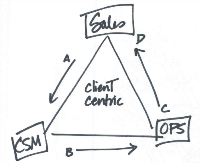January 20, 2026
Please join us for our January Luncheon on Tuesday, January 20, at the DoubleTree Roswell.
Register Today

Megan Perks, MBA, CMP, CMM
 |
Megan Perks, MBA, CMP, CMM |
Convention Sales & Meeting Management – A View from the Classroom
Wondering how to connect with college sophomores in a digital world? It’s not easy. Students don’t even buy textbooks anymore. “Why bother,” I was told, “the instructors just upload the diagrams and important pages.” Take notes? That’s archaic. Yet, when I would ask a student to put down his or her phone, the quick retort was always: “I was taking notes.”
As a newbie professor, I was thrown curve balls and fouled-out plenty of times with the students’ multiple attempts to test my tenacity. After the second week of class I decided to revamp my expectations and take a different approach. I resolved to focus on three key concepts as the essence of course objectives.
A few of the key takeaways I drilled at the beginning of each class:
- Market Segments – Group, Transient, and Leisure
- Hotel Classifications – Economy, Midscale, Upper Midscale, Upscale, Upper Upscale, and Luxury properties (STR Chain Scales)
- And, a Client-centric Sales & Services Model
The first two items are commonplace to industry professionals, but the third topic is probably a bit novel... that is because I made it up. When covering the meetings landscape, I was explaining the dynamic relationship between a meeting planner and a hotel: How the sales and services process begins and ends with the client, and the vital roles of how the sales manager, conference services manager (CSM), and operations departments must work in concert for a successful outcome.
Client-centric sales & services model:
 |
|
Fortunately, the students were impressed with my Service Triangle model. They really thought it came from the textbook and wanted to know what page to reference. I didn’t reveal “my source” until the last day of class.
Engagement is key.
The next generation of hospitality professionals are inquisitive and have a strong desire to be heard. Academics are encouraged to become less dependent on heavy bookwork, lectures, and PowerPoints. Applying active learning techniques, and at times flipping the classroom, is how I choose to engage students and deliver content in a meaningful way.
Sources:
Abbey, J. (2016). Convention sales and services (9th ed.). Waterbury Press.
Flipping the classroom. (n.d.). Cornell University. Center for Teaching Innovation website: https://teaching.cornell.edu/teaching-resources/designing-your-course/flipping-classroom
Love, J. (2018). The sales process [Blog]. ProSolutions. Retrieved from https://www.hotel-online.com/tag/sales-process

Leave a commentOrder by
Newest on top Oldest on top